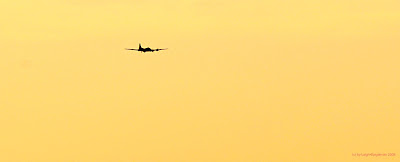Some would consider this to be a thorny beauty. I guess it's just nature's way of protecting what must be a delicious bloom, that is if you're a native animal to the Sonoran Desert.
 Like the ground? At least that's what this looks like. Buried under that sea of orange blossom is a tiny cactus somewhere. The one with the purple flower is a "hedgehog" cactus, as it's commonly called around here.
Like the ground? At least that's what this looks like. Buried under that sea of orange blossom is a tiny cactus somewhere. The one with the purple flower is a "hedgehog" cactus, as it's commonly called around here. My favorite? The Ocotillo. Or as I like to call them, the dead sticks. That's because in the winter, the leaves fall off and it looks for all the world like a dead stick with thorns. But come the rains and these masters of surprise grow leaves like a standard poodle grows hair.
My favorite? The Ocotillo. Or as I like to call them, the dead sticks. That's because in the winter, the leaves fall off and it looks for all the world like a dead stick with thorns. But come the rains and these masters of surprise grow leaves like a standard poodle grows hair. And although it's tough to see in this photo (unless you put your cursor on the picture and left click) the dead sticks also produce the BRIGHTEST orange flower at the very top of the individual sticks. You gotta see em to believe it.
And although it's tough to see in this photo (unless you put your cursor on the picture and left click) the dead sticks also produce the BRIGHTEST orange flower at the very top of the individual sticks. You gotta see em to believe it. And the color isn't exclusive to the desert cacti. You'll often see a lake of color, if the rains have come at the right time (this year's bloom is far superior to last years, thanks to some well timed rain back in January.) This splash of color is courtesy of the brittle bush.
And the color isn't exclusive to the desert cacti. You'll often see a lake of color, if the rains have come at the right time (this year's bloom is far superior to last years, thanks to some well timed rain back in January.) This splash of color is courtesy of the brittle bush. So, if someone tells you that all the desert is good for is a whacking good thorn in your side, well, you know better now.
So, if someone tells you that all the desert is good for is a whacking good thorn in your side, well, you know better now.












